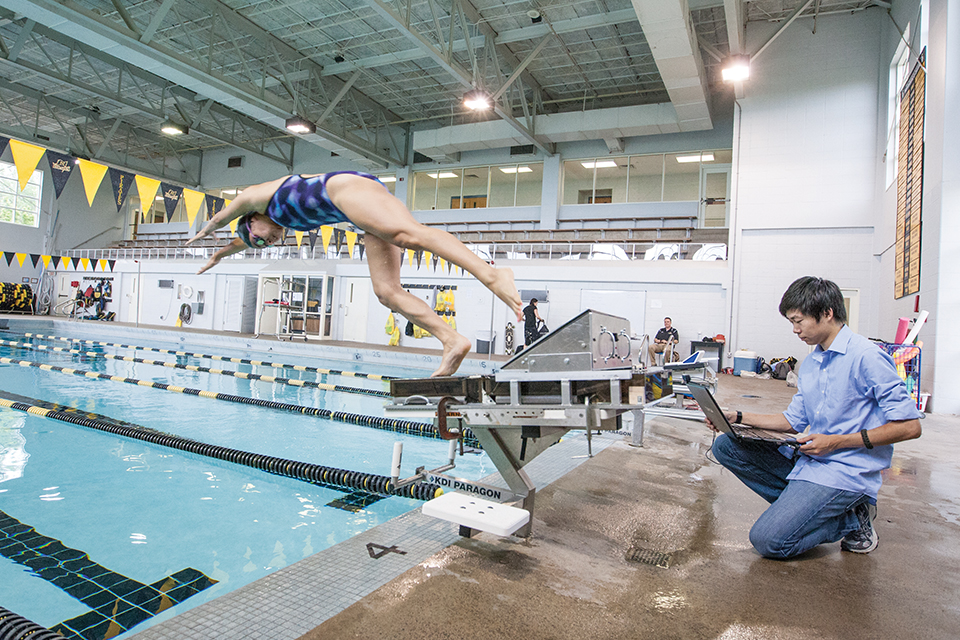Combining Science, Engineering, and Athletes

When we think sports, we’re typically thinking roaring crowds, adrenaline-fueled athletes, victory, and defeat. We’re not thinking pixels, bits, bytes, and staggering amounts of data. But we should be. Science and technology are making a fast break into the sports arena, and it’s making things a lot more exciting for all of us.
Patterns and predictive algorithms now complement plyometrics and supplements as part of the equation that is modern-day sports. Anticipating injuries is just as valuable as rehabbing through them. Sports science focuses on placing the right athletes in the absolute best scenarios for success, whether physically through complex roster analysis, emotionally through behavioral studies, or chemically through monitoring muscle growth. Positioning the proper players with the proper opportunities is what makes teams great. The growing number of metrics by which we judge athletes provides a fascinating pool of valuable data—data that can validate hunches, predict future success, and keep the dreaded draft day bust off of our favorite teams. QBR, WAR, and ORtg are no longer just formulas developed by Harvard statisticians; they’re ideas that have defined a generation of draft choices and comprise the storylines for blockbuster hit films and TV shows.
The way we view the game is changing, and engineers are the ones who have brought us here. If you’ve read the news lately, you’ve seen headlines about the lack of science, technology, engineering, and math (STEM) majors graduating from U.S. universities, and many opinions about how to fix the problem. Experts have suggested incentive systems, deferring student loans, and radically revamping curriculum in the hopes of attracting more students to pursue STEM degrees. Although the effectiveness of these programs is yet to be determined, we think we have a better solution. If you can get students to associate STEM with things they know and care about (like their cell phones or their favorite sports team), you’re going to get their attention.
What does this mean in the classroom? Rather than illustrating the concept of fatigue due to repetitive loading by bending a paper clip back and forth, talk about how LeBron’s legs are breaking down after jumping up and down for 48 minutes. Try teaching 11th graders relative speeds and acceleration by observing their track team’s 100-meter dash rather than demonstrating these concepts with static lines on a chalkboard. Want tangential and centripetal forces around an arc? Think hammer toss. Need to convey inelastic collisions? Watch a football game. If you want to convince more students to participate or stay in STEM programs, introduce them to interesting, fun applications like sports and see how they respond. It’s not rocket science—it’s sports science.
At National Instruments (NI), we’re passionate about this methodology because we build the hardware and software tools that engineers working in industry use to design systems. Everything from smartphones to medical devices to airplanes are built and tested using our tools. For the last few years, I’ve been putting these engineering tools into the hands of graduating students at universities around the U.S. in the hopes that they can become familiar with them before they leave school, and thus are prepared to make an impact in their new careers from Day One. Essentially, NI wants students to actually “do engineering” before graduating, and the topics of those projects don’t matter so long as the students become engaged and leave with an understanding of engineering theory and the ability to translate their years of labs into actual real-world projects.
Traditionally, my role is to develop project ideas that may appeal to electrical or mechanical engineers and send them to professors for evaluation. Example projects, such as "GPS Synchronization of Indoor Objects using USRPs and Telemetry" and "Camshaft Stress Investigation and Diagnostics in Bikes" were common, but I always included something like "Instrumented Swimming Platform to Train Swimmers to Get Faster" to satisfy my love of engineering and sports.
Each semester, the projects with a sports science theme always receive the most interest. In 2011, six University of Texas mechanical engineers adopted the idea of showing their engineering skills through sports. The first rendition was a great success, and we estimate that we achieved a 200 percent increase in the adoption and understanding of our hardware and software as compared with that in previous semesters. Eighteen months and 12 students later, we now have a "Smart Start Swimming Platform" that is being evaluated for use by the United States Olympic Committee, and all of the graduates have received offers or found jobs through citing the project as a showcase of their time in school. Since then, I have used athletics to teach more than 70 engineers, produce more than 15 projects, and, more importantly, expose the next batch of future students to the excitement of engineering. Our team members have produced things that track, path, plan, and inspire.
These days, the ideas I pass along to university professors look more like "Free Throw Analysis" (University of Houston), "Quarterback Eye Tracking" (Georgia Tech), and "ACL Injury Prevention through Relative Angles" (University of Delaware), though, every once in a while, I’ll throw in a "Solar Panel Emulation Board as it Relates to Power Consumption" for old times' sake. For me, however, the future of engineering retention lies between the hashes and the hardwood.
With the success of shows like ESPN's Sports Science and products such as the Nike+ shoes, it is fair to say that sports technology has reached the mainstream, and with it come new opportunities for athletes—and engineers—to grow. Giving engineering students an interesting way to learn about the concepts of science and technology is just a happy byproduct of the sports science revolution.






